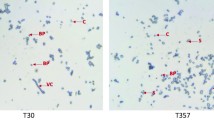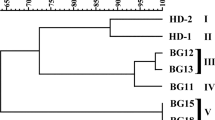Abstract
BUPM95 is a Bacillus thuringiensis subsp. kurstaki strain producing the Vip3Aa16 protoxin with an interesting insecticidal activity against the lepidopteran pest Ephestia kuehniella. The LC50 of Vip3Aa16 protoxin against first instar larvae of E. kuehniella (Lepidoptera: Pyralidae) was 31.36 ng/cm2 5 days post-treatment at 28 °C. Interestingly, this B. thuringiensis protoxin could relatively withstand environmental stresses such as extreme pH, temperature and UV radiations. Its larvicidal potency was also resistant to proteases action. These properties could be exploited for the formulation of a novel B. thuringiensis insecticide for effective biocontrol of undesirable lepidopteran larvae.



Similar content being viewed by others
References
Abdelkefi-Mesrati L, Boukedi H, Chakroun M, Kamoun F, Azzouz H, Tounsi S, Rouis S, Jaoua S (2011) Investigation of the steps involved in the difference of susceptibility of Ephestia kuehniella and Spodoptera littoralis to the Bacillus thuringiensis Vip3Aa16 toxin. J Invertebr Pathol 107:198–201
Abdelkefi-Mesrati L, Boukedi H, Dammak-Karray M, Sellami-Boudawara T, Jaoua S, Tounsi S (2011) Study of the Bacillus thuringiensis Vip3Aa16 histopathological effects and determination of its putative binding proteins in the midgut of Spodoptera littoralis. J Invertebr Pathol 106:250–254
Abdelkefi-Mesrati L, Tounsi S, Jaoua S (2005) Characterization of a novel vip3-type gene from Bacillus thuringiensis and evidence of its presence on a large plasmid. FEMS Microbiol Lett 244:353–358
Arthur FH (1996) Grain protectants: current status and prospects for the future. J Stored Prod Res 32:293–302
Becker N, Zgomba M, Ludwig M, Petric D, Rettich F (1992) Factors influencing the activity of Bacillus thuringiensis var. israelensis treatments. J Am Mosq Control Assoc 8:286–289
Bell CH (2000) Fumigation in the 21st century. Crop Prot 19:563–569
Caccia et al (2014) Proteolytic processing of Bacillus thuringiensis Vip3A proteins by two Spodoptera species. J Insect Physiol 67:76–84
Chakroun M, Bel Y, Caccia S, Abdelkefi-Mesrati L, Escriche B, Ferré J (2012) Susceptibility of Spodoptera frugiperda and S. exigua to Bacillus thuringiensis Vip3Aa insecticidal protein. J Invertebr Pathol 110:334–339
Ghribi D, Elleuch M, Abdelkefi-Mesrati L, Ellouze-Chaabouni S (2012) Evaluation of larvicidal potency of Bacillus subtilis SPB1 biosurfactant against Ephestia kuehniella (Lepidoptera: Pyralidae) larvae and influence of abiotic factors on its insecticidal activity. J Stored Prod Res 48:68–72
Gringorten JL, Milne RE, Fast PG, Sohi SS, van Frankenhuyzen K (1992) Suppression of Bacillus thuringiensis δ-endotoxin activity by low alkaline pH. J Invertebr Pathol 60:47–52
Jallouli W, Abdelkefi-Mesrati L, Tounsi S, Jaoua S, Zouari N (2013) Potential of Photorhabdus temperata K122 bioinsecticide in protecting wheat flour against Ephestia kuehniella. J Stored Prod Res 53:61–66
Lee MK, Miles P, Chen JS (2006) Brush border membrane binding properties of Bacillus thuringiensis Vip3A toxin to Heliothis virescens and Helicoverpa zea midguts. Biochem Biophys Res Commun 339:1043–1047
Lee MK, Walters FS, Hart H, Palekar N, Chen JS (2003) The mode of action of the Bacillus thuringiensis vegetative insecticidal protein Vip3A differs from that of Cry1Ab δ-endotoxin. Appl Environ Microbiol 69:4648–4657
Medeiros FP, Santos MA, Regis L, Rios EM, Rolim Neto PJ (2005) Development of a Bacillus sphaericus tablet formulation and its evaluation as a larvicide in the biological control of Culex quinquefasciatus. Mem Inst Oswaldo Cruz 100:431–434
Mittal PK (2003) Biolarvicides in vector control: challenges and prospects. J Vector Dis 40:20–32
Mittal PK, Adak T, Sharma VP (1995) Effect of water pH on the larvicidal activity of Spherix (Bacillus sphaericus) and Bactoculicide (Bacillus thuringiensis H-14) against mosquitoes. Natl Acad Sci Lett 18:189–191
Nayar JK, Knight JW, Ali A, Carlson DB, O’Bryan PD (1999) Laboratory evaluation of biotic and abiotic factors that may influence larvicidal activity of Bacillus thuringiensis serovar israelensis against two Florida mosquito species. J Am Mosq Control Assoc 15:32–42
Pozsgay M, Fast P, Kaplan H, Carey PR (1987) The effect of sunlight on the protein crystals from Bacillus thuringiensis var. kurstaki HD1 and NRD12: a Raman spectroscopic study. J Invertebr Pathol 50:246–253
Rees D (2003) Insects of stored products. CSIRO Publishing, London, p 181
Rouis S, Chakroun M, Saadaoui I, Jaoua S (2007) Proteolysis, histopathological effects, and immunohistopathological localization of δ-endotoxins of Bacillus thuringiensis subsp. kurstaki in the midgut of Lepidopteran olive tree pathogenic insect Prays oleae. Mol Biotechnol 35:141–148
Venables WN, Smith DM (2004) The R Development Core Team. An Introduction to R Version 1.9.1. http://www.r-project.org/
Acknowledgments
This work was supported by grants from the Ministry of Higher Education and Scientific Research, Tunisia.
Author information
Authors and Affiliations
Corresponding author
Ethics declarations
Conflict of interest
Hanen Boukedi, Slim Tounsi and Lobna Abdelkefi-Mesrati declare that they have no conflict of interest.
Rights and permissions
About this article
Cite this article
Boukedi, H., Tounsi, S. & Abdelkefi-Mesrati, L. Abiotic factors affecting the larvicidal activity of the Bacillus thuringiensis Vip3Aa16 toxin against the lepidopteran pest Ephestia kuehniella . J Plant Dis Prot 123, 59–64 (2016). https://doi.org/10.1007/s41348-016-0004-5
Received:
Accepted:
Published:
Issue Date:
DOI: https://doi.org/10.1007/s41348-016-0004-5




